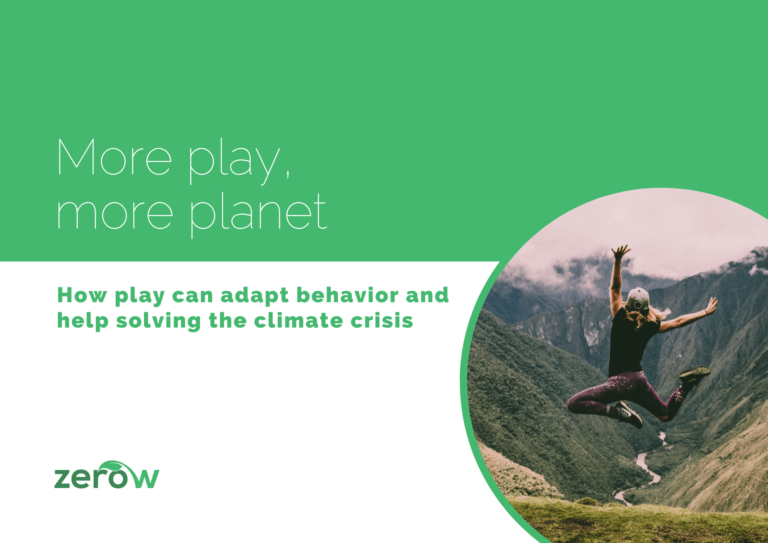How play adapts behavior and helps solve the climate crisis
-
By Antoin Linssen
- July 13, 2022
Share this article
We all know it, we are facing a climate crisis. And human behavior is hindering us from getting out of the crisis. The many priorities and distractions we have make it difficult for us to truly act. So what happens if we change our human behavior?
Humans could collectively reduce meat consumption, stop using fossil fuels, waste less, and use circular materials. This alone can give our children a future with enough food, water, medicine and natural resources without the need for conflicts caused by climate-related shortages and threats.
But how do we get ourselves to learn more and change our behavior? Here’s an unconventional but powerful idea you may not have thought about.
Want the “long-read” of this topic with all insights, examples and advice? Then please download the whitepaper.

Let’s have fun in making meaningful change for our climate
We need some fun while making a difference. Not for the selfish reasons that play is fun, but because we know play is a powerful mechanism to adapt behavior.
If you take a look at how we develop ourselves, it’s through play. Think about the times you (or your children) learned to walk, talk, fight, play soccer, read, and so on. Most of us learned it through certain concepts of play. Remember the good feeling when you got a high grade at school (goal achievement), or the big warm hug (reward) you received from your mother when you took your first steps.
Also in adult work life it’s there – e.g. in competitions to become the best salesperson of the year, winning an engineering contest, or simply the good feeling when you puzzled a lot with your Excel formulas and tables and finally got them to work. You performed better because a form of play was involved. Play is a universal development mechanism. It helps us grow and adapt to our environment.
Seeing the concept of play from this perspective, we can leverage it to benefit the planet. If business and government organizations would start to design more playful activities, we could trigger mass behavioral adaptation and help solve the climate crisis. But to know how to leverage play here, we first need to better understand how play adapts behavior.
3 factors how playful interventions affect behavior
Playful interventions trigger humans to adapt and make better choices for our environment. We become more motivated and more able to act.
To design playful interventions, let’s dive deeper to understand how play influences behavior. Behavior is the sum of three factors: Motivation, Ability and Prompt (source: BJ Fogg). For each of these three factors, we explain how a playful intervention affects us.

1. Motivation
We are motivated to act because either we ourselves want to do something (intrinsic) or something else pushes us to do something (extrinsic). Extrinsic motivators are of material value, like discounts, free gifts, salary increases, taxes, etc. They have a powerful but short-term effect. To have a powerful long-term effect, we need to raise intrinsic motivation.
Want to learn more about how motivation works? Download the full whitepaper of this topic with all insights, examples and solutions
A playful activity is fun. The whole play design triggers your intrinsic motivation – whether it’s the story, mechanics, visual design, goal, or all of these combined. What motivates you depends on the type of person you are. It could be to dominate & compete to be the best, explore & discover new things, collect items or achievements, tackle intelligent puzzles, build something beautiful together, etc etc. Good play architects (including game designers) know the target group’s intrinsic motivations, and design a playful activity that attracts you and makes you spend time on it.
In addition, playful activities are positive and open minded. You can try things within a safe environment. There is no negativity or fear. If you mess up it’s OK. You just start again. And well-balanced playful activities ensure the activity is not too difficult in the start, but become more difficult when your skills increase, to make sure you keep a high motivation. This is the opposite of the negative and depressing climate-related messages we see in the news. We eventually become numb and stop consuming that content.

2. Ability
Imagine we are fully motivated to act. Then we still have four ability-related barriers standing in the way of adapting behavior.
- Awareness. Do we know about climate change-related issues?
- Deeper understanding. Do we understand the causes, consequences, and solutions?
- Skills. Do we have the skills to respond?
- Resources. Do we have the time, physical & mental capabilities, and financial resources available?
A playful activity is an active process. Watching a movie is a passive activity, where you don’t need to (inter)act to influence the result of the movie. A playful activity requires you to act. Your action creates a reaction. And your actions influence the end result. This active mental state enables you to absorb new knowledge, develop physical or cognitive skills and better maintain that new developed ability.
Throughout this process, a well-designed activity can increase awareness, understanding and skills, including giving you good insights on how to best leverage your available resources.
Through the playful activity, a normally tedious, negative and paternalistic message becomes a fun and positive exercise. They stay exposed to the activity and return to it long and frequently enough so that they can absorb and maintain all relevant knowledge and skills. When this is achieved, the barrier to adapt to the new behavior drops, and opens up the path to act.
3. Prompt
Finally, we need a trigger pushing you to take a specific action. It could be an event or a person giving you that final nudge. Humans are inclined to return to our default behavior, so having a recurring trigger at the right time can help train that newly gained behavior.
Mobile games are powerful instruments of play, since the phone sensors have the ability to measure your actions and can send recurring push notifications to keep people doing the intended behavior. Having said that, mobile (or digital) games are not always the solution. It always depends on the user and the given situation.
After being exposed to the new behavior frequently, it will become our new default behavior. Mission accomplished – we adapted human behavior.
Bringing it all together
A well-designed playful activity raises motivation, builds abilities and prompts people to think and act differently than what they did before. Understanding this powerful concept is the basis for behavioral adaptation.
So how to move forward? We need to design playful systems people can play with and through the process of play adapt their behavior. In the design process, research your intended user and behavior. And then design a playful activity that motivates the person, builds up abilities and finally frequently triggers the user with the activity. And it can be done anywhere – at schools, businesses, homes, events, shops and in the digital ecosystem.
The whitepaper on this topic gives a few tangible points what to consider when creating a playful activity that adapts behavior.
Let’s have fun while making a difference for our climate
To survive as humans, we need to act now. But let’s have fun while doing it. And not for the selfish reasons that play is fun, but because we know play is a powerful mechanism to behavioral adaptation.
That’s it. So please consider in whatever activity you set up, how a playful design can trigger your employees, customers, friends and families to act. It will change our lives today, and our lives in the future. Let’s become game changers.
Interested to see how play could help in your climate change challenge? Connect with us. We may be able to help.

